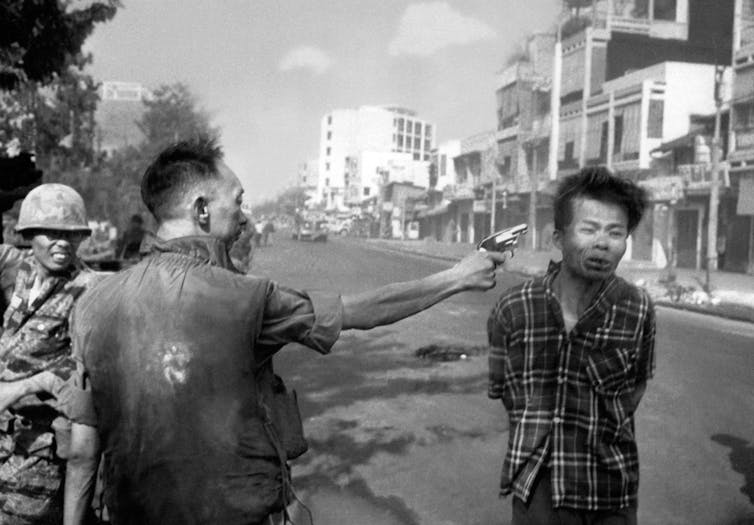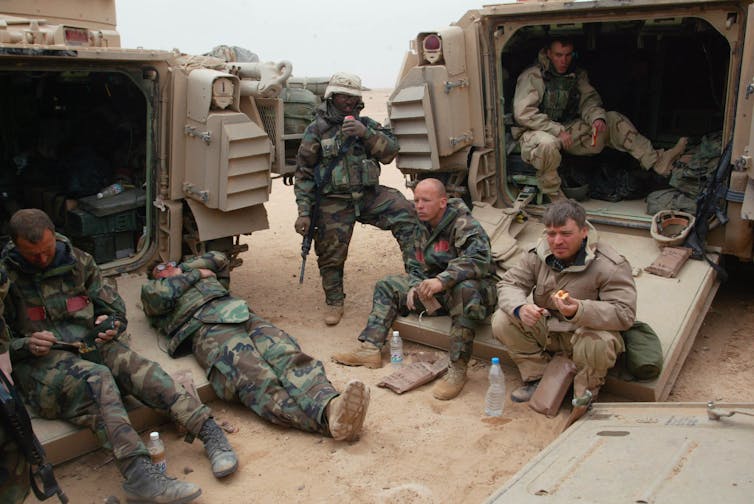What Was The Vietnam Syndrome
In August 1965, Morley Safer, a reporter for "CBS News," accompanied a unit of measurement of U.S. marines on a search-and-destroy mission to the Vietnamese village of Cam Ne. Using cigarette lighters and a flamethrower, the troops proceeded to burn down downward 150 houses, wound 3 women, kill one kid and accept iv men prisoner. Safer and his crew caught information technology all on motion picture. The armed forces command after claimed that the unit had received enemy fire. But according to Safer, no pitched battle had taken place. The just death had been the male child, and non a single weapon had been uncovered.
In describing the reaction, Safer would later say that the public, the media and the military all began to realize that the rules of war reporting had changed.
The New Yorker's Michael Arlen dubbed Vietnam the "living room war." The images of the war – viewed on evening news shows on the country'due south three networks – enabled the public to sympathize the war's human costs. In this sense, media coverage contributed to the menses of information that's vital to any functioning republic, and pushed Americans to either support or oppose U.S. interest in the disharmonize.
However, in the state's myriad military machine conflicts since Vietnam, this flow of information has been largely transformed, and it is now more difficult to run across the man consequences of armed forces operations. Despite a digital revolution that'southward created even more opportunities to transmit images, voices and stories, the public finds itself further removed from what'southward really happening on the front lines.
A imitation narrative exposed
Bug of truth, representation, interpretation and baloney prevarication at the core of the media's presentation of war. And then do ability and control.
Governments aren't ever afraid to show the public what state of war looks similar. During World State of war II, journalists were subject to censorship. Yet in September 1943, President Roosevelt and the War Department immune Life magazine to publish George Strock's moving photo of three dead American soldiers sprawled on Buna Embankment in the Pacific.
That decision pointed to the administration's confidence that the public would go along to support the military, even after existence brought – every bit the accompanying Life editorial noted – "into the presence of their ain dead."
But Vietnam destroyed the assumption that the public would e'er back up their authorities'due south military policies, and the images accompanying the disharmonize were partly responsible.
In Safer's case, afterwards a heated debate among CBS officials, the footage of American troops setting fire to a Vietnamese hamlet was shown on "The CBS Evening News" with Walter Cronkite.
The regime seemed to recognize the power of this footage: It reacted swiftly – and from the top.
The next morning, President Lyndon B. Johnson called CBS president Frank Stanton to berate the network for airing the footage.
"You know what you did to me last night?" Johnson asked.
"What?" Stanton replied.
"You shat on the American flag."
The Pentagon was besides furious considering the story challenged their own narrative – that enemy troops had died, and that American troops were able to distinguish the Viet Cong from the local population.
Safer'southward images would resonate in American culture. Torching a hamlet or field came to exist chosen a "Cipher mission," while scenes of setting villages on fire appeared in many Vietnam State of war films.
More dramatic images emerged from the war, many of which remain familiar today. There'due south Nick Ut's photo of nine-year-erstwhile Kim Phoc fleeing her napalmed village; Eddie Adams's shot of South Vietnamese Full general Nguyen Ngoc Loan summarily executing a Viet Cong on a Saigon street; and Ronald Haeberle's devastating pictures of the 1968 My Lai massacre.

They didn't automatically create public backlash. Simply viewers couldn't ignore the anarchy that seemed to be emerging from the battlefield. And this had the net effect of debunking the government's claim that the military machine was making significant progress in Vietnam. A growing number of critics outside – and, significantly, inside – the administration argued the war could not be won.
A new media strategy emerges
On rest information technology would seem that more than skepticism when it comes to judging the demand to go to war is a good thing.
Not everyone, however, would agree. In the years after Vietnam, some members of the political and military establishment wanted to be able to use war machine force without feeling hamstrung by the possibility of public opposition.
To them, public exposure to bloodshed and the resulting disfavor to going to war had go a major problem. They even had a name for information technology – the "Vietnam syndrome" – and information technology required a new media strategy.
1 solution involved imposing strict command over the movements of journalists. The government could no longer afford to allow – every bit it had in Vietnam – enterprising reporters to run around the battlefield, going wherever they wanted and speaking with whomever they pleased.
During Grenada, Panama and the Gulf War, they organized journalists into small "pools" that had tightly controlled access to the battlefield (if at all).
Fifty-fifty with these restrictions in place, the Pentagon bristled at CNN's dramatic broadcasts of the bombing of Baghdad during Operation Desert Storm. It'southward non as if the cable network was even criticizing the attacks; it was the very images of U.S. aircraft bombing a major urban center that defence officials establish so unsettling. The soundtrack alone – the thump of high-yield explosions, the sirens of emergency vehicles, the staccato of anti-aircraft fire – ran counter to the administration'southward preference for their own soundless footage of smart bombs existence smoothly guided to their military targets.
Entertain – but don't inform
Some journalists started to complain well-nigh the pool system and tried to strike out on their own. By the 1990s, the almost astute media managers within the Pentagon realized that censorship and other efforts to straight command the media were likely to incite criticism and public backfire.
So other strategies emerged. Instead of denying admission to the battlefield, they hoped to shift what journalists would report from the battleground. The war would become localized through man interest stories, told by "embedded reporters" attached to units. Behind this was a advice strategy to make reporters more inclined to describe the daily lives of soldiers, rather than the broader military machine and political objectives. Quiet heroism would replace loss; hometown celebrations would supercede critical reviews of policy and strategy.
At first glance, the Pentagon's preference for "embedded reporting" evokes the Vietnam-era practice of allowing journalists to piece of work amongst gainsay soldiers. But in Afghanistan and Iraq there was a primal difference. Vietnam provided an gauge window to the consequences of gainsay. In Iraq, journalists were close to the fighting but provided a very different type of drama.
Viewers back abode were treated to green-hued images from nighttime scopes and the shaky footage from hand-held cameras. The jumpy videos created tension, but didn't bring the audition any closer to the pain of war. Viewers understood state of war through powerful just distracting footage, rather than through the visceral images of devastation, anarchy and tragedy that the media was able to capture during the Vietnam era.

Furthermore, government officials discovered that they could enjoy more sympathetic reporting from those who became an accepted member of a "ring of brothers." At the same time embedded reporters offered a kind of credibility that government spokespeople didn't possess. Pictures and stories of troops providing nutrient, medical aid, and other forms of assistance to Iraqi civilians – and even to wounded Iraqi soldiers – emerged easily.
But the pain of the battlefield – the physical and psychological repercussions – remained remote. It wasn't fifty-fifty possible to see pictures of returning body containers until the Obama administration reversed the policy in 2009.
There are exceptions. Some excellent journalists did manage to communicate the costs to America's war machine and to the local population. In some cases, revelations emerged from the proliferation of new media outlets.
Today, "the living room state of war" is now a distant memory. The public no longer receives all of its data from the aforementioned three channels. Instead, there are thousands of media outlets all covering the same conflicts, from dissimilar perspectives – with some state of war coverage veering into amusement and fifty-fifty celebration.
"Let the awful images haunt united states," Susan Sontag in one case wrote.
It's an invocation to not turn away from the dramatic images of battle, no matter how painful or agonizing. Going to war is arguably 1 of the most important decisions a country can make; for this reason, access to the true sacrifices, costs and horrors should not exist restricted.
What Was The Vietnam Syndrome,
Source: https://theconversation.com/how-the-pentagon-tried-to-cure-america-of-its-vietnam-syndrome-83682
Posted by: barteltdoccap.blogspot.com


0 Response to "What Was The Vietnam Syndrome"
Post a Comment